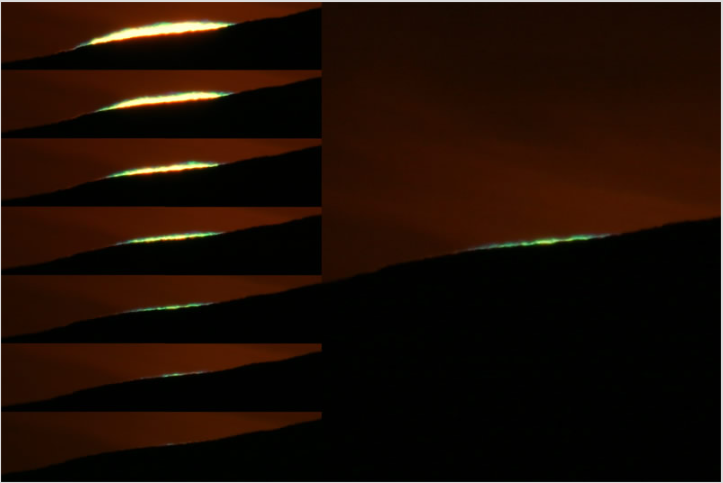Green flashes - sunset over a distant hillside
Green Flashes - Sunset Over a Distant Hillside
Have you ever witnessed a mesmerizing green flash during sunset? This captivating phenomenon occurs when the sun dips below the horizon, especially when viewed from a distant hillside. In this article, we will delve deeper into the science behind green flashes and explore how they are intensified when the sun sets behind a hill.
When the air moves across a hill, it undergoes compression, resulting in a sharpening of temperature gradients and a curvature of the isotherms towards the Earth. This compression of the vertical temperature profile enhances miraging, creating the perfect conditions for green flashes to occur. The compressed isotherms contribute to an inferior mirage-like flash that appears just above the astronomical horizon.
Interestingly, a similar phenomenon can be observed when stars and planets set behind a hill. Due to the compressed isotherms and enhanced atmospheric refraction, these celestial objects may appear to creep along the rim of the hill before eventually setting. This delay in their descent is a result of the planet being raised by atmospheric refraction.
The images captured by Tony Cook, overlooking the Wharfe valley from Bramhope, Leeds in Yorkshire, England, provide a stunning visual representation of green flashes over a distant hillside. The hill edge, approximately 12 miles away, serves as a frequent source of these captivating flashes. The direction of the wind blowing from the hillside contributes to the unique atmospheric conditions necessary for this phenomenon to occur.
To capture these breathtaking moments, Cook used a Canon 10D camera with a Sigma 500mm APO telephoto lens equipped with a x2 teleconverter. The exposures were taken on August 6th, 2005, with settings of 1/4000s shutter speed, f8.0 aperture, and ISO 100. These technical details highlight the precision required to capture the elusive green flashes during sunset.
Green flashes have long been a subject of fascination for sky gazers and photographers alike. They are often described as a brief burst of green light that appears just above the horizon as the sun sets or rises. While the exact mechanisms behind green flashes are still not fully understood, they are believed to be caused by atmospheric refraction and scattering of sunlight.
The phenomenon of green flashes occurs due to the bending of light as it passes through the Earth's atmosphere. As the sun nears the horizon, its light must traverse a larger portion of the atmosphere, causing it to undergo greater refraction. This refraction separates the different colors of light, with shorter wavelengths, such as blue and green, being more strongly refracted than longer wavelengths like red and orange.
When atmospheric conditions are just right, these shorter wavelengths of light can become concentrated, resulting in a distinct green flash. The green color is thought to be a combination of the scattering of blue light and the selective absorption of red light by the Earth's atmosphere. This creates a momentary burst of green that can last for just a fraction of a second.
In conclusion, witnessing a green flash during sunset over a distant hillside is a truly awe-inspiring experience. The unique atmospheric conditions created by the wind blowing across the hill, combined with the compression of temperature gradients and enhanced atmospheric refraction, contribute to the intensity of these flashes. Photographs like those captured by Tony Cook allow us to appreciate the beauty and wonder of this natural phenomenon. So next time you find yourself observing a sunset from a hillside, keep your eyes peeled for the elusive green flash that may just appear before your eyes.

The sun sets behind a distant hill. Tony Cook (see his Tenerife image) took this sequence looking up the Wharfe valley from Bramhope, Leeds in Yorkshire, England. The hill edge is about 12 miles away and is a frequent source of flashes. The wind was from the direction of the hillside. When air moves across a hill the vertical temperature profile is compressed; temperature gradients are sharpened and the isotherms curved concave towards the earth. This favours miraging and could be responsible for the inferior mirage like flash taking place here above the astronomical horizon. A related phenomenon is that stars and planets setting behind a hill sometimes appear to creep along its rim. The compressed isotherms enhance atmospheric refraction, raise the planet and thus delay setting.
Exposures: 6th August 2005, Canon 10D, 1/4000s f8.0 at ISO 100, Sigma 500mm APO telephoto with x2 teleconverter.
Images ©2005 Tony Cook, reproduced with permission.
Note: this article has been automatically converted from the old site and may not appear as intended. You can find the original article here.
Reference Atmospheric Optics
If you use any of the definitions, information, or data presented on Atmospheric Optics, please copy the link or reference below to properly credit us as the reference source. Thank you!
-
<a href="https://atoptics.co.uk/blog/green-flashes-sunset-over-a-distant-hillside/">Green flashes - sunset over a distant hillside</a>
-
"Green flashes - sunset over a distant hillside". Atmospheric Optics. Accessed on December 24, 2024. https://atoptics.co.uk/blog/green-flashes-sunset-over-a-distant-hillside/.
-
"Green flashes - sunset over a distant hillside". Atmospheric Optics, https://atoptics.co.uk/blog/green-flashes-sunset-over-a-distant-hillside/. Accessed 24 December, 2024
-
Green flashes - sunset over a distant hillside. Atmospheric Optics. Retrieved from https://atoptics.co.uk/blog/green-flashes-sunset-over-a-distant-hillside/.